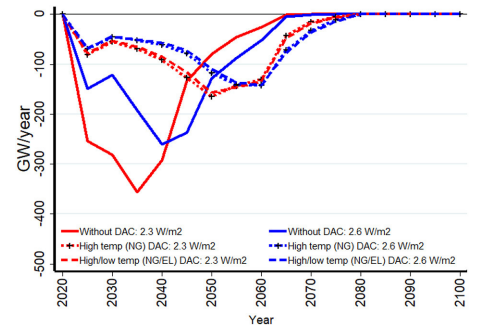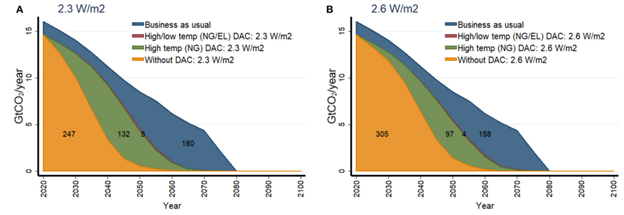Effects of Direct Air Capture Technology Availability on Power Sector
This study shows how the availability of direct air capture (DAC) affects the quantity of stranded assets – fossil fuels and infrastructure that are retired early and remain unused – created under the goal of limiting global warming to 1.5°-2°C. There is a growing recognition that limiting global warming will require countries to retire a significant amount of the existing electricity generation infrastructure, creating unusable infrastructure and fuel stocks that cannot be burned. The types and degree of asset stranding depend on the cost and availability of negative emission technologies (NETs). This paper uses the Global Change Analysis Model (GCAM) integrated assessment model to examine how climate policy affects the premature retirement of assets in the global power sector and how that stranding is affected by the expected future deployment of direct air capture and carbon storage.

The study finds that under the climate mitigation goal of limiting the warming to 1.5°-2°C, using DAC would lower stranding in the power sector, reduce the stranding of coal and gas plants, and delay the future stranding of these plants. The availability of direct air capture would reduce the need to eliminate already committed CO2 emissions in order to achieve the climate goal. Without the availability of DAC, 46–57% of the expected CO2 emissions would need to be eliminated. If DAC is deployed, only 28–33% of expected emissions would need to be eliminated, thereby reducing the quantity of stranded assets.

Additionally, direct air capture technologies are in an early stage of technological development and the current cost estimates do not include the potential value from the use of captured CO2 as a feedstock. For example, the pure stream of CO2 generated from DAC could either be used either as a feedstock in catalytic processing to make synthetic hydrocarbons, such as liquid fuel, or in building materials like plastic polymers, or in the production of low carbon cements. These valuable products would provide an additional incentive for DAC deployment, making this a fruitful and interesting area for further research.
For the full study, download the file below.


